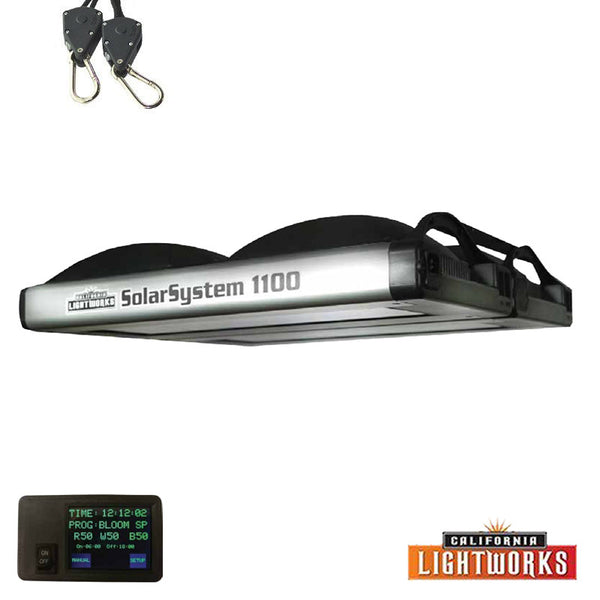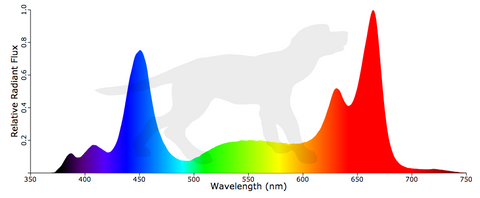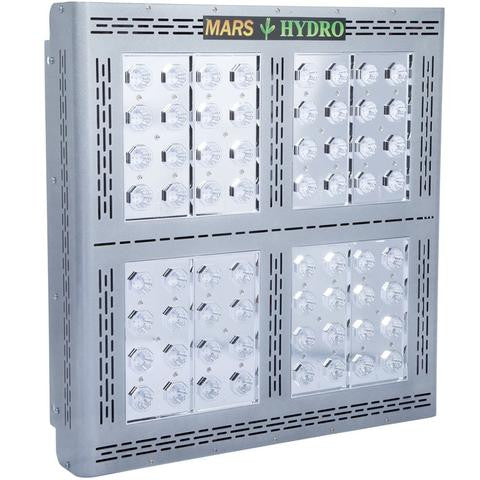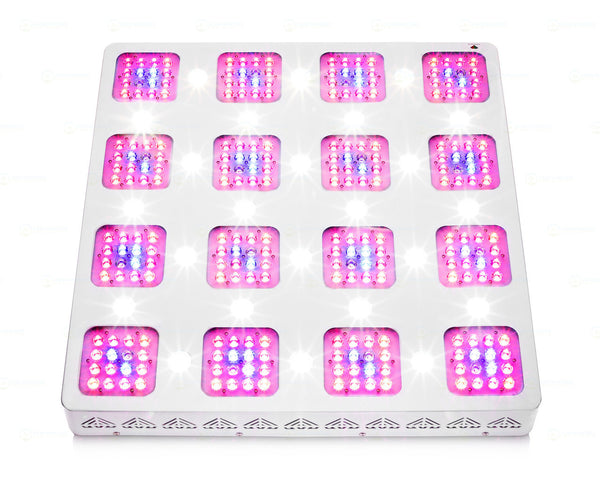How To Choose the Perfect LED Light For Growing Indoor Plants
Image: California Lightworks SolarSystem 1100 LED grow light
So, you want to know what the best LED grow lights are? Well, that depends on many factors. This guide will help you understand the world of LED grow lights and increase your knowledge before you buy that special light(s) for your precious grow. Happy growing!
Plant Type and Phase
Low light vs High light conditions
Do the plants need full sun or low-light conditions? Dimmable LED lights may be the way to go for adjusting the Photosynthetic active radiation (PAR) beaming from your fixture. Dimmable LEDs (such as California Lightworks, Cirrus LED, Lifted LED, Kind LED) allow you to vary the light output without adjusting the height of the light and allow you to dim the lights down for Veg and increase the light intensity for Flower, or to mimic eseasonal light changes that some plants require.
Image: Kind LED XL1000 - Dimmable/customizable spectrum
Vegging vs Flowering
Are you vegging, flowering, or both? There are LED lights for growing that are designed specifically for vegging your plants (blue shifted lights) and LEDs for flowering your plants (red spectrum lights). Light fixtures with these specific spectrums may also be used in addition to full spectrum LED grow lights or other types of grow lighting to provide an extra boost during veg and bloom phases of your grow. G8LED offers a red booster for that extra flowering boost. Typically, most LED grow lights
Typically, most LED grow lights provide a full spectrum and can be used for the entire cycle from seed to harvest
Black Dog LED PhytoMAX-2 Review
Growth Spectrum
Red and blue light are crucial
If you would like to grow from seedling to flower, then a full-cycle LED grow light is recommended. A full-cycle grow light will provide your plants with the blue and red wavelengths that are needed for optimal growth. Blue light mimics the long day, summer sun and encourages vegetative leaf growth (MH, or Metal Halide, lamps also provide this function). When choosing an LED grow light ensure the unit includes blue lights in the range of 440-470nm. Red light is also important in plant growth and is a primary driver for photosynthesis. Red light takes the place of the short day, autumn sun. (HPS, or High Pressure Sodium, lamps provide a red-leaning spectrum). When combined with blue light, a hormone cascade is created and the red wavelengths begin to encourage flowering. Look for lights that have red light in the 640-660 range.
Many LED grow lights are full-spectrum grow lights and contain blue, green, red (which creates a white light or reddish light depending on the amount of green) and somtimes infrared (IR) and ultraviolet (UV). Greenlight, IR, and UV have been shown to increase plant growth (green light and IR) and flower quality (UV).
Image: Lighting Science VividGro™ V2 - red and blue diodes (red heavy)
UV is a supercharger
In addition to red and blue diodes, you may consider a light that contains UV wavelengths. UV light activates the plant's defense mechanisms, affects plant development, growth, and metabolism. UV wavelengths can also increase THC. Choose LED grow lights that have diodes in the 315-400nm range (380nm is common.) UVA is a common LED wavelength used in grow lights. UVB is more expensive and is not seen too often in LED grow lights. Cirrus LED has a bar light that contains UV-B diodes (below).

Image: Cirrus LED UVB bar light
White light
Some LED grow lights are designed with white LED diodes such as the NextLight Mega LED Grow Light (below), Pro MAX Grow lights, and Amare, who use white chip-on-board (COB) LEDs with other wavelength diodes to fill out the entire spectrum from deep blues to IR (and UV with the SolarEclipse SE450 grow light). Quality white LEDs, adjusted for the correct wavelengths and color temperature, provide full-spectrum white light from deep blues to far reds, however are typically missing UV and IR. Make sure that the color of the LEDs (in Kelvins) are in a mid-temperature range. 4000K is a nicely balanced color that will provide the blues need for growth and the reds required for flowering. NextLight, Pro MAX Grow, and Amare LED fixtures have been shown to grow from seed to flower with excellent flowering results
Image: NextLight Mega LED grow light - 650W - white diodes, full spectrum
The best LED spectrums for plant growth
In summary, the best lights for growing indoor plants will include red and blue LEDs (at the correct wavelengths) or a full-spectrum white light. UV diodes may be included to enhance a plant's physiological functions, but these are not required. A 6:1 or 5:1 ratio of red to blue is ideal for boosting yields, but can create stretched plants during Veg and reduce flower quality. A red to blue ratio or 2:1 or 1:1 is ideal for keeping stout and increasing resin production. Of course individual results will vary based on grower experience, strain, nutrients, environment, etc. Before you purchase and LED grow light, look at the spectral curve to ensure it is what you and your plants desire.
A good example of a great spectrum: Black Dog LED PhytoMAX-2 series
Image: Black Dog LED PhytoMAX-2 200 with UV and IR
Image: Kind LED Bar Light 4' Flower B - The 'B' (Micro) Versions contain UV and IR
Coverage Area
Light size
The grow light that you choose should depend on the area you want to cover. A small 100 watt light may cover less than 4 sq ft, while a large 400 watt light can cover about 12 sq ft. Some growers recommend purchasing a larger light, because it is cheaper (watt for watt) and they can always back the light off from the plants if the light radiation is too intense. However, this will also reduce the PAR that reaches your plant so may not be ideal. Dimmable LED grow lights may be advantageous since the intensities can be dialed down. But the best light to buy is the fixture that covers the exact space you need it to cover. Assume about 32 watts per square foot of grow space. These are actual watts that are drawn at the wall and not LED wattage.
Related: How many LED watts do I need for my grow space?
 Beam Angle
Beam Angle
A larger light will cover a larger area with more even and intense coverage than a smaller light that spreads the light over a greater distance. For smaller grows, purchase several lower powered fixtures instead of fewer high powered fixtures for the most even coverage on your plants.
In addition to the size of the LED grow light, the beam (or lens) angle matters too. A small angle (30 degrees) decreases coverage area, but delivers more PAR to your plants. A large angle (65 degrees) expands the overall light footprint, but reduces the light density delivered to the plants. Apache Tech, for example, offers customizable angles on their LEDs --- either 14 or 50 degrees or a blend of both. You might consider larger angle lenses if the light is hung close to the plants. Wider beam angles can assist in canopy penetration since the beams are shooting in sideways through the canopy.
Advertised LED Chip Wattage
Most growth studies suggests that the best wattage for an LED chip is 3 watts. 1-watt chips give off the least amount of heat, are the most efficient, and are the most stable and long lasting. However, some people claim most 1-watt chip lights may not pack the power required to penetrate deep into the plant canopy. Growers and LED companies state that 3-watt LED chips possess the perfect balance between cost, size, and heat generation (or lack-there-of). In addition to the 1-watt and 3-watt chips, are 5-watt chips and higher. These are the most intense, but are least efficient and might not last as long as 1-watt chips. Overall, chip wattage does not matter too much. LED grow lights with lower wattage chips simply need more chips on the fixture, while
In addition to the 1-watt and 3-watt chips, are 5-watt chips and higher. These are the most intense, but are least efficient and might not last as long as 1-watt chips. Overall, chip wattage does not matter too much. LED grow lights with lower wattage chips simply need more chips on the fixture, while grow lights with higher wattage chips need fewer. The NextLight Mega, for example, uses many low wattage chips while the Johnson Grow Lights CX-16 contains 16 high wattage COBs. They are both great LED grow lights.

Image: Horticultural Lighting Group HLG 550
Shop LED Grow Lights ›
Actual LED Output Wattage
You don't always get what you see
The ‘actual LED output wattage’ differs from the ‘advertised LED output wattage’ by up to 50-75% Companies may advertise that they use 3-watt chips in their LED grow lights, however, the diodes are not powered to full capacity. A 3-watt LED is usually driven between 500mA and 700mA, with most LEDs running at 550mA in order to increase the lifespan of the diode. Therefore a 3-watt chip may only draw 1.7 watts, depending on the wavelength.
Comparing LED grow light power
When comparing LED lights to HID lighting (HPS/MH), use the actual LED output wattage. To get an equal amount of photosynthetic active radiation from LEDs as you would HID lighting, use about 50-75% less wattage than a HID setup. For example, to get 1000 watts of actual LED power you could use 2 LED panels that draw 500 watts of power in place of a 1500-2000 watt HID system. These numbers represent a wide range, and the actual power will differ depending on the brand, diodes, lenses, etc. Most importantly, do not use the advertised wattage of, say, a panel that has 350 x 3 watt chips. This does not equal 1050 watts of actual power. It is closer to 500-600 watts of actual LED power. Therefore, always use the actual wattage, also known as the watts consumed at the wall, to determine the wattage of an LED grow light. All other wattages are not that important.
Lifetime
LED lights will last you 50,000-100,000 hours or more before the light intensity reaches 70% (L70).
Related: How many LED watts do I need for my grow space?
Cooling System
LED base and heatsink
Choose an LED light that contains a metal core printed circuit board (MCPCB). These fixtures incorporate a base metal as a heat spreader and keeps the chips running at a lower temperature. This is important in extending the life of the LED. The LEDs should be mounted to a thick, finned, aluminum or copper heatsink. Most, if not all common LED grow lights on the market use quality PCBs and heatsinks, so cool should not be much of an issue when deciding on and LED grow light. But as with all products some are better than others. Buy a popular brand and you shouldn't have to worry about these factors.
Cooling Fans
LED grow lights sometimes contain internal cooling fans to rid any excess heat that may shorten the life of the diodes. (Only about 15-25% of the energy that LEDs output is turned into heat. This is extremely efficient compared to HPS and MH bulbs that expel 80% of their energy as heat.) Some greenhouse and research LED grow lights do not have cooling fans due to the low-heat emitting LEDs and/or design. This is convenient because the lights require less power since they are not running internal cooling equipment. Some of the grow light brands that do not have internal cooling fans include GE Lighting, HLG, Lighting Science, NextLight, Philips GreenPower, Illumitex, and Pro Max Grow. Many growers prefer the absence of cooling fans, because it is one less part that could potentially break on the unit.
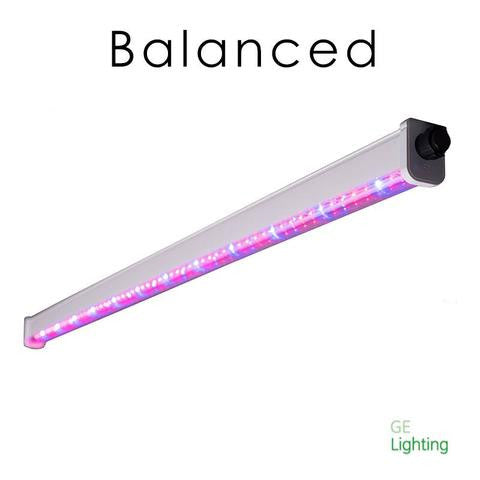
Image: GE Lighting Arize LED grow light bar
Construction
Unit Housing
High-quality LED grow lights are made with a metal (typically aluminum) housing. If the unit is plastic do not purchase it. Aluminum is an excellent heat conductor and helps transfer excess heat that is produced by the LEDs.
Driver
Look for grow lights that contain a ‘constant-current’ driver, as opposed to a ‘constant-voltage’ driver. An LED's voltage tends to drop as they get warm. A constant current driver will keep the current steady as the LED voltage changes with the increasing temperature. This will extend the life of the diodes. All LED grow lights these days should contain constant-current driver.
Return Policy and Warranty
Return policies on LED lights will vary and range from no returns to 90 days (most common). A 3-year warranty on your grow light is ideal. Some companies even offer 5-year warranty, such as Amare (some lights), Cirrus LED, Illumitex, NextLight, and Lighting Science.
Brand
You get what you pay for
When buying and LED grow light, you get what you pay for. Good companies make good lights. If you buy ‘no-name’ lights from eBay, Amazon, or Alibaba you will get a unit that burns out fast. The brands that we sell at LED Grow Lights Depot have made many growers happy --- just check out the reviews of some of these lights online. Some are smaller companies, some larger, other from China, and some are U.S. made. Many well-constructed LED grow lights are designed in the U.S. and manufactured in China. There is nothing wrong with this, because often they are made to an American company’s specifications and whether they are or not, these lights have proven their worth. Other brands, such as Mars Hydro are designed and manufactured in China and are great lights - especially considering their inexpensive cost compared to other LED grow lights.
Image: Mars Hydro Pro II Epistar 320
Lumens and PAR
Lumens are for Humans
You may have seen LED grow light information listed in Lumens and PAR. Lumens do not matter --- at least not to a plant. Lumens are a measure of the amount of visible light emitted from a source. Chlorophyll mostly absorbs light in the blue range, red range, and far ranges of the visible spectrum. Chlorophyll does not efficiently absorb green or yellow wavelengths (although evidence suggests that green light helps drive photosynthesis). In sum, lumens do not tell us how well plants will respond to visible light.
PAR sets the Bar
PAR, or photosynthetically active radiation, is a measure of photosynthetic light energy (400nm-700nm range) that falls on the plant each second. PAR does matter. It is important for plant growth, yet, many cheap PAR meters read the entire PAR range and not just the wavelengths required for photosynthesis.
A spectroradiometer is the best tool used to measure PAR, especially for when comparing LED grow lights to fluorescent, HPS, or MH systems. A spectroradiometer measures the energy at each specific wavelength.
It is best to ask the manufacturer how they obtained their PAR readings. When you know the umol readings (PAR/PPFD) for a grow light you are able to place it at the correct heights for optimal PAR coverage.
For a further discussion on PAR, PPF, PPFD, and DLI see this page.
Do LEDs Work for Growing Plants and Flowering?
Yes. They certainly do! Keeping the above points in mind when purchasing an LED grow light will ensure that you buy a light that will grow your plants well. Remember that LED grow lights can be designed for different uses (veg / flowering / full cycle), so make sure that you are purchasing the correct LED spectrum for your growing needs. It is always best to go with a full cycle light (all brands offer a full cycle light) if you are unsure of what you need.
Image: Advanced LED Lights XML 650
LEDs past and present
You may have seen many claims on the internet stating that LED grow lights do not work that well for flowering. This is not true anymore. In the past, LEDs were not adjusted for proper growth and flowering when they first arrived on the market not too long ago. Small-operation growers lost money and valuable harvests, and shunned away from LED lights. They stated that these lights were a waste of money. Hearing their claims, more testing was done at LED manufacturers and the correct spectrums for plant growth and flowering were developed. Now there are many LED grow lights that successfully grow and flower plants. If you decide to purchase lights for growing, please double-check that they have some backing --- that other growers have had success with these lights. Do not believe the marketing hype that many companies shout. Reviews, testimonials, forums, and word of mouth will be your best references!
LEDs are the future
The LED grow light market is taking off! At first, many insufficient LED grow lights were sold to consumers. These days, we have many great LEDs that grow better than HPS and MH systems. As time goes on, the market will drive the ‘bad’ LED grow lights out and favor the LEDs that perform well. Also, LED technology will continue to improve and costs will drop, passing the savings on to the consumer. Right now, start-up costs for growing using LEDs can be high, but the investment of a quality light should last you at least 10 years! You can’t say this about traditional grow lighting. The cost savings of an LED light will usually come after about three years, but sometimes less than one. However, this number will depend on many other factors, for example, the size of your grow and HVAC system. Given some time, LED grow lights will replace traditional HPS and MH bulbs in nearly every grow room and greenhouse.
With all of the above points in mind, you are on your way to choosing the very best LED grow light for your money and crop.
If you want more information on the best LED grow lights for growing indoor plants or for other horticultural purposes, please contact us.
For awesome discounts and LED news, sign up for our mailing list located in the footer of this page!
Note: Please be aware that the cultivation of certain plants may or may not be legal within your own specific region or country. LED Grow Lights Depot does not encourage or condone any illegal activity and advises each individual / user to inform themselves of the relevant laws within their own region/country.






